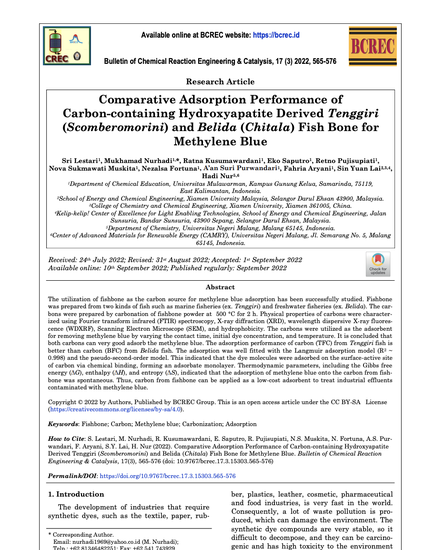
Article
Comparative Adsorption Performance of Carbon-containing Hydroxyapatite Derived Tenggiri (Scomberomorini) and Belida (Chitala) Fish Bone for Methylene Blue
Bulletin of Chemical Reaction Engineering & Catalysis
(2022)
Abstract
The utilization of fishbone as the carbon source for methylene blue adsorption has been successfully studied. Fishbone was prepared from two kinds of fish such as marine fisheries (ex. Tenggiri) and freshwater fisheries (ex. Belida). The car- bons were prepared by carbonation of fishbone powder at 500 °C for 2 h. Physical properties of carbons were characterized using Fourier transform infrared (FTIR) spectroscopy, X-ray diffraction (XRD), wavelength dispersive X-ray fluorescence (WDXRF), Scanning Electron Microscope (SEM), and hydrophobicity. The carbons were utilized as the adsorbent for removing methylene blue by varying the contact time, initial dye concentration, and temperature. It is concluded that both carbons can very good adsorb the methylene blue. The adsorption performance of carbon (TFC) from Tenggiri fish is better than carbon (BFC) from Belida fish. The adsorption was well fitted with the Langmuir adsorption model (R 2 ~ 0.998) and the pseudo-second-order model. This indicated that the dye molecules were adsorbed on the surface-active site of carbon via chemical binding, forming an adsorbate monolayer. Thermodynamic parameters, including the Gibbs free energy (ΔG), enthalpy (ΔH), and entropy (ΔS), indicated that the adsorption of methylene blue onto the carbon from fishbone was spontaneous. Thus, carbon from fishbone can be applied as a low-cost adsorbent to treat industrial effluents contaminated with methylene blue.
Keywords
- Fishbone,
- Carbon,
- Methylene blue,
- Carbonization,
- Adsorption
Disciplines
Publication Date
September 10, 2022
DOI
https://doi.org/10.9767/bcrec.17.3.15303.565-576
Citation Information
Sri Lestari, Mukhamad Nurhadi, Ratna Kusumawardani, Eko Saputro, et al.. "Comparative Adsorption Performance of Carbon-containing Hydroxyapatite Derived Tenggiri (Scomberomorini) and Belida (Chitala) Fish Bone for Methylene Blue" Bulletin of Chemical Reaction Engineering & Catalysis Vol. 17 Iss. 3 (2022) p. 565 - 576 ISSN: 978-2993 Available at: http://works.bepress.com/hadi_nur/240/
